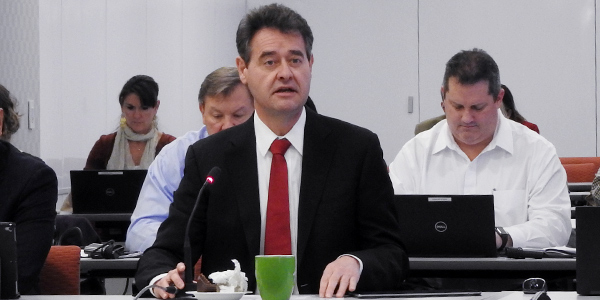By Rory D. Sweeney
VALLEY FORGE, Pa. — PJM CEO Andy Ott attended last week’s Markets and Reliability Committee meeting to respond to concerns about the Board of Managers’ recent ultimatum around price formation — and members were more than happy to offer additional ones.
Under the gun of the board’s Jan. 31 deadline to revise six characteristics of PJM’s energy market price formation, stakeholders last week heard first reads of three alternative proposals. (See PJM Moving Quickly to Make Board’s Price Formation Deadline.)
Ott said the board felt several of the revisions for which it intends to request FERC approval are “no-brainers” in that they have already proven successful in solving other problems for PJM.
“We feel we are correctly criticized as a region for not addressing known price anomalies,” Ott said. “There is a very strong opinion by the board that we are long overdue for these changes.”
He said PJM staff could provide additional data for stakeholder analysis after the revisions have been implemented, but “we’re not in that mindset right now” to wait for additional data to validate the revisions. “As a board, we felt that these issues had been discussed for years.”
Responding to concerns about whether the board was fully apprised of activity in the Energy Price Formation Senior Task Force (EPFSTF), Ott said they are “well aware” and have had a “complete discussion of where the stakeholders were.” Instead of asking to slow down changes, stakeholders should be helping PJM speed them up, he said.
“The pace of the industry is not going to slow down for us. In fact, it’s going to accelerate,” he said. “On some of the very big and broad issues, we struggle on how to get them through in a way that’s timely. … These are so obvious that we need to get it through to FERC. … We don’t feel it’s rushed; we feel it’s actually delayed.”
Greg Poulos, executive director of the Consumer Advocates of the PJM States (CAPS), said he is fielding questions from his members asking why this is happening now when major changes are already imminent for other PJM markets, including capacity and financial transmission rights.
“It seems like everything is happening at once,” he said.
“The fact that the votes haven’t happened, it’s not delay. It’s truly trying to do the right things by the market,” said Susan Bruce, representing the PJM Industrial Customer Coalition. “We have almost a fiduciary responsibility” to understand the full impacts of the proposal before going to FERC, particularly if stakeholders are going to be asked to endorse it.
Ott acknowledged that some issues, such as alignment of day-ahead and real-time reserves, haven’t been discussed and hoped that they could be addressed in January.
Collapse the Process
The call to immediate action left some stakeholders questioning the value of debating the issues within PJM.
“You have stated that the stakeholder process is antiquated and of no real use to you,” said Ruth Ann Price of the Delaware Division of the Public Advocate. “Perhaps we need to collapse the stakeholder process and just go directly to FERC.”
Ott admitted that the board did discuss making a unilateral filing under Section 206 of the Federal Power Act rather than issuing its Dec. 5 letter to stakeholders, but he said he “feels very strongly that stakeholder input is vital.”
“Time and time again, the stakeholder process has improved proposals, and we believe that,” he said. “I think it’s of tremendous value.”
While PJM comprehensively outlined its proposal to meet the board’s demands, it was unclear which member company would be motioning or seconding it for consideration. The proposal includes increasing the penalty factor for pricing reserve scarcity in the operating reserve demand curve (ORDC) to $2,000/MWh.
Still a work in progress, a second proposal from the D.C. Office of the People’s Counsel mainly focuses on maintaining the current $850/MWh ORDC penalty factor.
PJM’s Independent Market Monitor presented its alternative, which remained unchanged from its EPFSTF proposal that would, among other things, delineate smaller subzones and create an ORDC “based on analysis of actual operator demand for additional reserves.” Monitor Joe Bowring said the ORDC is “overstated” in PJM’s proposal.
Finally, Calpine’s David “Scarp” Scarpignato proposed to implement PJM’s proposal without a “transitional mechanism for the energy and ancillary services (E&AS) revenue offset to reflect expected changes in revenues in the determination of the net cost of new entry.” Spark spreads have been “coming down,” Scarp said, but a “high variance” remains between expected and actual E&AS revenues.
Stakeholders will vote on the issue at the Jan. 24 MRC meeting.



